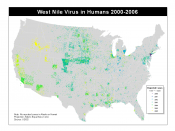Viruses have been causing human aliment and trouble from the beginning of time however they were not thoroughly understood or know until the beginning of the twentieth century. It is an unbelievable thought that something so tiny so microscopic can cause such problems. The word by itself translates into Latin as Poison (Wiki#1). Unlike human cells or bacteria, viruses do not contain the chemical machinery or enzymes needed to carry out the chemical reactions to sustain life. Instead, viruses carry only one or two enzymes that decode their genetic instructions into the host cells. So, a virus must have a host cell (bacteria, plant or animal) in which to live and make more viruses. Outside of a host cell, viruses cannot function. For this reason, viruses tread the fine line that separates living things from nonliving things. Most scientists agree that viruses are alive because of what happens when and after they infect a host or carrier cell.
A virus particle, or virion, consists of the following things; Nucleic acid which is a set of genetic instructions, either DNA or RNA, either single-stranded or double-stranded. They can not replicate by themselves without taking control of a cell's biosynthetic machinery. Some even contain enzymes known as reverse transcriptase that can synthesize DNA from the RNA. The only viruses that can not make DNA are corona viruses such as SARS. They also contain a protein coat around the virus which is made of protein subunits they protect the enclosed nucleic acids when the virus is not contained within a host cells (wiki#1). Often times the protein coat contains small receptors much like cilia but these receptors act in the opposite, they help the virus bind into the cell so that infection can occur. The protein coat surrounding the virion mutates at such...


